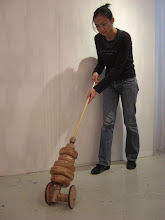•Refer to the eastern half of the Roman Empire (eastern Christian Roman Empire) •Constantinople’s original name: Byzantine
•The Byzantine emperors called themselves Romans, though they spoke Greek instead of Latin
•The westward flight of Byzantine scholars from the Rome of the East introduced the study of classical Greek to Italy and helped inspire there the new consciousness of antiquity that historians call the Renaissance.
•The Byzantine emperors called themselves Romans, though they spoke Greek instead of Latin
•The westward flight of Byzantine scholars from the Rome of the East introduced the study of classical Greek to Italy and helped inspire there the new consciousness of antiquity that historians call the Renaissance.
Icons & Iconoclas
Christ as Pantokrator, come mosaic in the Church of the Dormition, Daphni, Greece, ca. 1090-1100.

Christ as Savior of Souls, icon from Saint Clement, Ohrid, Macedonia, early 14th century. Tempera, Linen, and silveron wood, 3’1/4” X 2’ ½”
Fully modeled head and nect contrast with the schematic linear folds of his garment

12-19
Virgin (Theotokos) and Child enthroned, apse mosaic, Hagia Sophia, Constintinople (Istanbul), Turkey, dedicated 867
Shortly after the repeal of iconoclasm, the emperor Basil I dedicated a huge new mosaic depicting the Virgin and child enthroned.

12-29
Virgin (Theotokos) and Child ,icon, (Vladimir Virgin), late 11th to early 12th centuries. Tempera on wood, original panel 2’ 6.5” X 1’9”. Tretyakov Gallery, Moscow.
In this icon, the artist depicted Mary as the Virgin of Compassion, who presses her cheek against her son’s as she contemplates his future.
Gothic Art
•Humanists of Italian Renaissance actually considered Gothic art ugly and crude. However, in 13th and 14th century, the Gothic style was very popular in Europe.
•In 1337, the Hundred Years’ War began, affecting the peace between France and England. In the 14th century, a great plague, the Black Death, swept over western Europe and killed at least a quarter of its people.

•Other important changes:
1.intellectuals and religious men moved from monasteries in the countryside to rapidly expanding cities
2.urban centers started to have the first modern universities (founded by guilds of scholars
3. Crusades fought against the Muslims to have the more independent nations of modern Europe
Gothic architecture
•In 1337, the Hundred Years’ War began, affecting the peace between France and England. In the 14th century, a great plague, the Black Death, swept over western Europe and killed at least a quarter of its people.

•Other important changes:
1.intellectuals and religious men moved from monasteries in the countryside to rapidly expanding cities
2.urban centers started to have the first modern universities (founded by guilds of scholars
3. Crusades fought against the Muslims to have the more independent nations of modern Europe
Gothic architecture






Virgin with the Dead Christ , from the Rhineland, Germany, ca. 1300-1325. Painted wood, 2’10.5” high.

12-19
Virgin (Theotokos) and Child enthroned, apse mosaic, Hagia Sophia, Constintinople (Istanbul), Turkey, dedicated 867
14th century: widespread troubles: war, plague, famine, social strife…. Other sufferings… This sensibility could be found in religious art, e.g. Rottgen Pieta (“pity” in Italian). The sculpture portrayed Christ as a stunted, distorted human covered with streams of blood. àagony(very painful), death, sorrow

Virgin with the Dead Christ(Rottgen Pieta) , from the Rhineland, Germany, ca. 1300-1325. Painted wood, 2’10.5” high
In 14th century, art addressed the private person (often in a private place) ina direct appeal to the emotions. The expression of felling accompanied the representation of the human body in motion. The details of artworks became more outwardly related to the human audience as expressions of recognizable human emotions.
Transition to early Renaissance


•Although religion continued to occupy a primary position in the lives of Europeans, a growing concern with the natural world, the individual, and humanity’s worldly existence characterized the Renaissance period.
•Renaissance: “rebirth” of art and culture
•àrestoration of the glorious past of Greece and Rome and abandoned the styles in “middle ages”
•Italian humanists were concerned mainly with human values and interests (not religion came first). They recovered a large part of the Greek and Roman literature and philosophy that had been lost in the Middle Ages
Transition to early Renaissance


Gitto Di Bondone (1266-1377) was regarded as the first Renaissance painter: first in pursing a naturalistic approach to representation based on observation. He also helped establish painting as a major art form for the next 7 centuries. He and his followers suggested the visual world must be observed before it can be analyzed and understood.
Transition to early Renaissance


In Giotto’s painting:
-Madonna’s body is not lost. Mary’s breasts pressing through her undergarment.
-gold highlights on the robe have disappeared
-to construct a figure that has dimensionality and bulk (these are not shown in Byzantine art which focus on the spiritual immateriality mainly)
-portray sculpturesque figures--- giving them shadows
-mark the end of medieval painting and the beginning of a new naturalistic approach to art
Renaissance Perspectival systems
















































